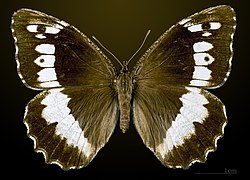White forest porter
| White forest porter | ||||||||||||
|---|---|---|---|---|---|---|---|---|---|---|---|---|

White forest porter ( Aulocera circe ) |
||||||||||||
| Systematics | ||||||||||||
|
||||||||||||
| Scientific name | ||||||||||||
| Aulocera circe | ||||||||||||
| ( Fabricius , 1775) |
The white forest porter ( Aulocera circe ) is a butterfly (day butterfly ) from the noble butterfly family (Nymphalidae). The specific epithet is derived from Circe , a sorceress from Greek mythology .
features
The moths reach a wingspan of 55 to 65 millimeters. They have very dark brown colored wing tops on which a conspicuous, wide white transverse band, which divides into individual spots on the wing outer edge. The broad, whitish band can also be seen on the dark gray-brown underside of the hind wings. But it is a bit dull in color. There is also a weakly indicated second band near the base of the wing, which clearly distinguishes this species from the great forest porter ( Hipparchia fagi ). But it only extends to the middle of the wing. On the underside of the forewings, near the tip, there is a large gradual white spot with a black point in the middle.
The caterpillars are approx. 35 millimeters long and are colored light gray-brown. They have a dark gray stripe on the back and next to it several weak side stripes. The head capsule is conspicuously patterned with six gray-brown stripes.
Similar species
- Great forest porter ( Hipparchia fagi )
- Small forest porter ( Hipparchia alcyone )
Synonyms
- Brintesia circe
- Kanetisa circe
- Satyrus circe
Way of life
The moths fly annually in one generation from early June to mid-September. In contrast to the Great Forest Porter, you can often see them on blossoms.
development
The females throw their eggs on the ground in flight. The caterpillars then look for a suitable forage plant. They overwinter when they are adolescents and pupate the next year in an underground chamber.
Food of the caterpillars
The caterpillars feed on the leaves of upright brusque ( Bromus erectus ) and real sheep fescue ( Festuca ovina ). They can also be found on other sweet grasses .
Occurrence
The animals are found in southern and central Europe , Turkey , Iran and the Himalayas up to an altitude of 1,650 meters. They are particularly common in the Mediterranean area , but are very rare in the warm areas of southern Germany . They are particularly found on dry grass near forests .
Hazard and protection
The white forest porter has become rare or has become extinct in many areas. Measures for the conservation of the species are difficult because the species neither populates completely free grasslands or heather nor overbush areas.
- Red list FRG: 2 (endangered)
- Baden-Württemberg red list: 2 (endangered)
swell
Individual evidence
- ^ Arnold Spuler: The butterflies of Europe . tape 1 . E. Schweitzerbartsche Verlagbuchhandlung, Stuttgart 1908, p. 41 .
- ↑ a b c d e f Heiko Bellmann : The new Kosmos butterfly guide. Butterflies, caterpillars and forage plants. Franckh-Kosmos, Stuttgart 2003, ISBN 3-440-09330-1 , p. 206.
- ^ A b Tom Tolman, Richard Lewington: The butterflies of Europe and Northwest Africa , Franckh-Kosmos Verlags-GmbH & Co, Stuttgart 1998, ISBN 3-440-07573-7
- ^ Josef Settele, Roland Steiner, Rolf Reinhardt, Reinart Feldmann: Butterflies. The butterflies of Germany. , Eugen Ulmer KG, 2005, ISBN 3-800-14167-1
- ↑ Federal Agency for Nature Conservation (Ed.): Red List of Endangered Animals in Germany. Landwirtschaftsverlag, Münster 1998, ISBN 3-89624-110-9
literature
- Günter Ebert (Hrsg.): The butterflies of Baden-Württemberg Volume 2, Tagfalter II (Augenfalter (Satyridae), Bläulinge (Lycaenidae), Dickkopfalter (Hesperiidae)), Ulmer Verlag Stuttgart 1993. ISBN 3-8001-3459-4
- Günter Ebert (Hrsg.): The butterflies of Baden-Württemberg Volume 10, supplementary volume, Ulmer Verlag Stuttgart 2005. ISBN 3-800-14383-6
Web links
- Lepiforum e. V. Taxonomy and Photos
- www.schmetterling-raupe.de
- Moths and Butterflies of Europe and North Africa (English)
- Fauna Europaea (English)



